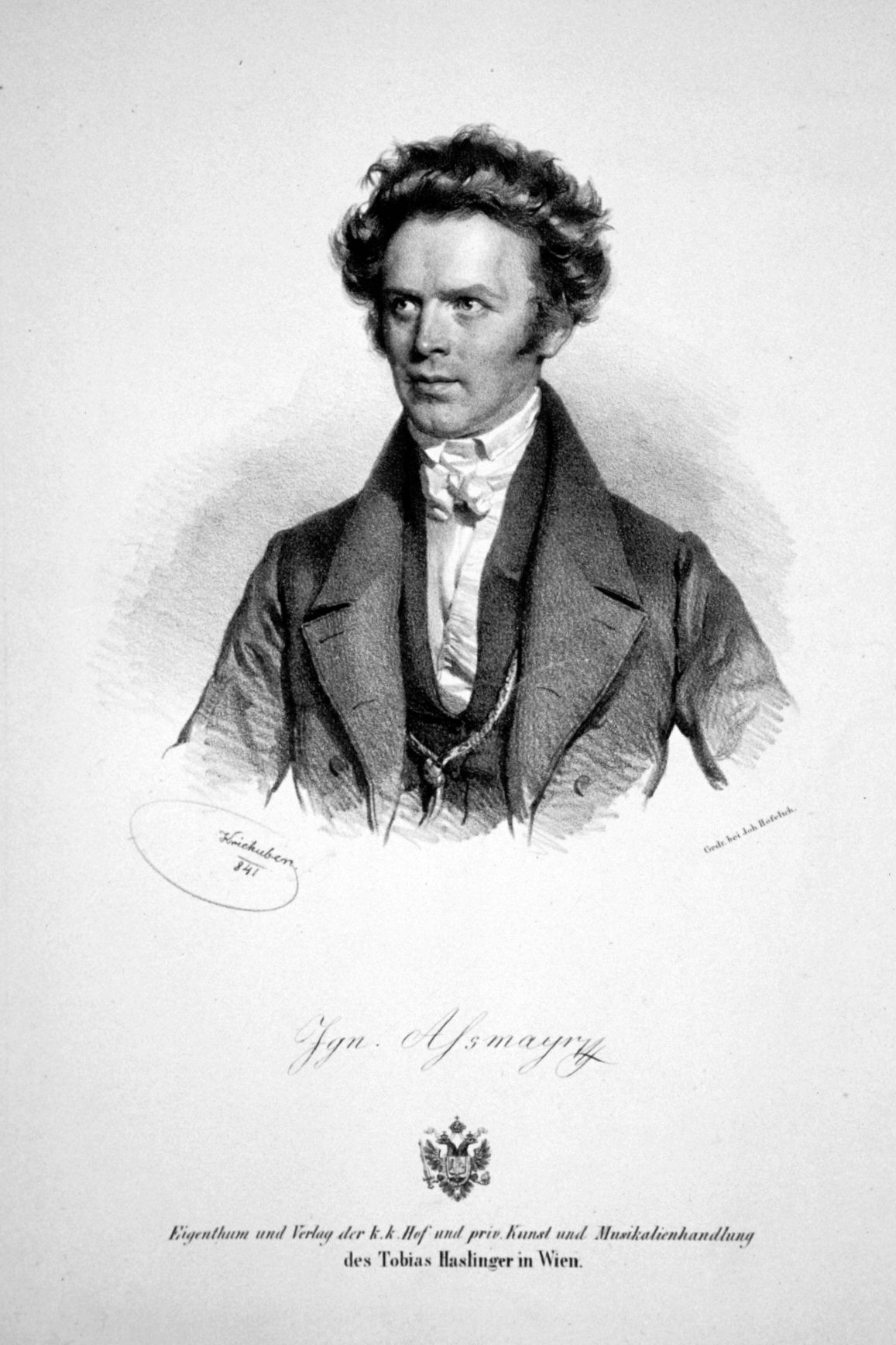Ignaz Assmayer on:
[Wikipedia]
[Google]
[Amazon]
 Ignaz Assmayer (11 February 1790 – 31 August 1862) was an Austrian composer of liturgical music. An organist at St. Peter's Abbey in Salzburg, he lived in Vienna from 1815, and was in 1846 the conductor of the Court Orchestra. Assmayer was a friend of
Ignaz Assmayer (11 February 1790 – 31 August 1862) was an Austrian composer of liturgical music. An organist at St. Peter's Abbey in Salzburg, he lived in Vienna from 1815, and was in 1846 the conductor of the Court Orchestra. Assmayer was a friend of
Information about the Masses in D and C
{{DEFAULTSORT:Assmayer, Ignaz 1790 births 1862 deaths 19th-century Austrian people 19th-century musicians Austrian male musicians Musicians from Salzburg 19th-century Austrian male musicians
 Ignaz Assmayer (11 February 1790 – 31 August 1862) was an Austrian composer of liturgical music. An organist at St. Peter's Abbey in Salzburg, he lived in Vienna from 1815, and was in 1846 the conductor of the Court Orchestra. Assmayer was a friend of
Ignaz Assmayer (11 February 1790 – 31 August 1862) was an Austrian composer of liturgical music. An organist at St. Peter's Abbey in Salzburg, he lived in Vienna from 1815, and was in 1846 the conductor of the Court Orchestra. Assmayer was a friend of Franz Schubert
Franz Peter Schubert (; 31 January 179719 November 1828) was an Austrian composer of the late Classical and early Romantic eras. Despite his short lifetime, Schubert left behind a vast ''oeuvre'', including more than 600 secular vocal wor ...
.
Life
Assmayer was born atSalzburg
Salzburg (, ; literally "Salt-Castle"; bar, Soizbuag, label=Bavarian language, Austro-Bavarian) is the List of cities and towns in Austria, fourth-largest city in Austria. In 2020, it had a population of 156,872.
The town is on the site of the ...
. He studied under Andreas Brunmayr and Michael Haydn
Johann Michael Haydn (; 14 September 173710 August 1806) was an Austrian composer of the Classical period, the younger brother of Joseph Haydn.
Life
Michael Haydn was born in 1737 in the Austrian village of Rohrau, near the Hungarian border. ...
, and later, when he went to Vienna, he received further instruction from Joseph Leopold Eybler. In 1808 he was organist at St. Peter's in Salzburg, and here he wrote his oratorio "Die Sündfluth" (The Deluge) and his cantata "Worte der Weihe".
Some time after his move to Vienna, in 1815, he became choirmaster at the Schotten Kirche, and in 1825 was appointed imperial organist. After having served eight years as vice-choirmaster, he received in 1846 the appointment of second choir-master to the Court, as successor to Joseph Weigl
Joseph Weigl (28 March 1766 – 3 February 1846) was an Austrian composer and conductor, born in Eisenstadt, Hungary
Hungary ( hu, Magyarország ) is a landlocked country in Central Europe. Spanning of the Carpathian Basin, it is ...
. He died in Vienna
en, Viennese
, iso_code = AT-9
, registration_plate = W
, postal_code_type = Postal code
, postal_code =
, timezone = CET
, utc_offset = +1
, timezone_DST ...
.
Works
His principal oratorios, "Das Gelübde", "Saul und David", and "Sauls Tod", were repeatedly performed by theTonkünstler-Societät
The Tonkünstler-Societät ("Society of Musicians") was a benevolent society for musicians in Vienna, which lasted from the mid-18th century to the mid-20th. Its purpose was "to support retired musicians and their families". Beginning in 1772, the ...
, of which he was conductor for fifteen years. He also wrote fifteen masses, two requiems, a Te Deum, and various smaller church pieces. Of these, two oratorios, one mass, the requiems, and Te Deum, and furthermore sixty secular compositions, comprising symphonies, overtures, pastorales, etc., were published.
In the 1820s, he was one of 50 composers to write a '' Variation on a theme of Anton Diabelli
Anton (or Antonio) Diabelli (5 September 17818 April 1858) was an Austrian music publisher, editor and composer. Best known in his time as a publisher, he is most familiar today as the composer of the waltz on which Ludwig van Beethoven wrote ...
'' for Part II of the ''Vaterländischer Künstlerverein
''Vaterländischer Künstlerverein'' was a collaborative musical publication or anthology, incorporating 83 variations for piano on a theme by Anton Diabelli, written by 51 composers living in or associated with Austria. It was published in t ...
''. Part I was devoted to the 33 variations supplied by Beethoven
Ludwig van Beethoven (baptised 17 December 177026 March 1827) was a German composer and pianist. Beethoven remains one of the most admired composers in the history of Western music; his works rank amongst the most performed of the classical ...
, which have gained an independent identity as his ''Diabelli Variations
The ''33 Variations on a waltz by Anton Diabelli'', Op. 120, commonly known as the ''Diabelli Variations'', is a set of variations for the piano written between 1819 and 1823 by Ludwig van Beethoven on a waltz composed by Anton Diabelli. It for ...
'', Op. 120.
As to his style, '' Grove'' calls it correct and fluent, but wanting in both invention and force.
References
* Susanne Antonicek: ''Ignaz Assmayr (1790 – 1862). Biographie und Messenschaffen mit thematischen Katalog seiner Werke''. Phil. Thesis. Vienna 2001. ;Attribution *External links
*Information about the Masses in D and C
{{DEFAULTSORT:Assmayer, Ignaz 1790 births 1862 deaths 19th-century Austrian people 19th-century musicians Austrian male musicians Musicians from Salzburg 19th-century Austrian male musicians